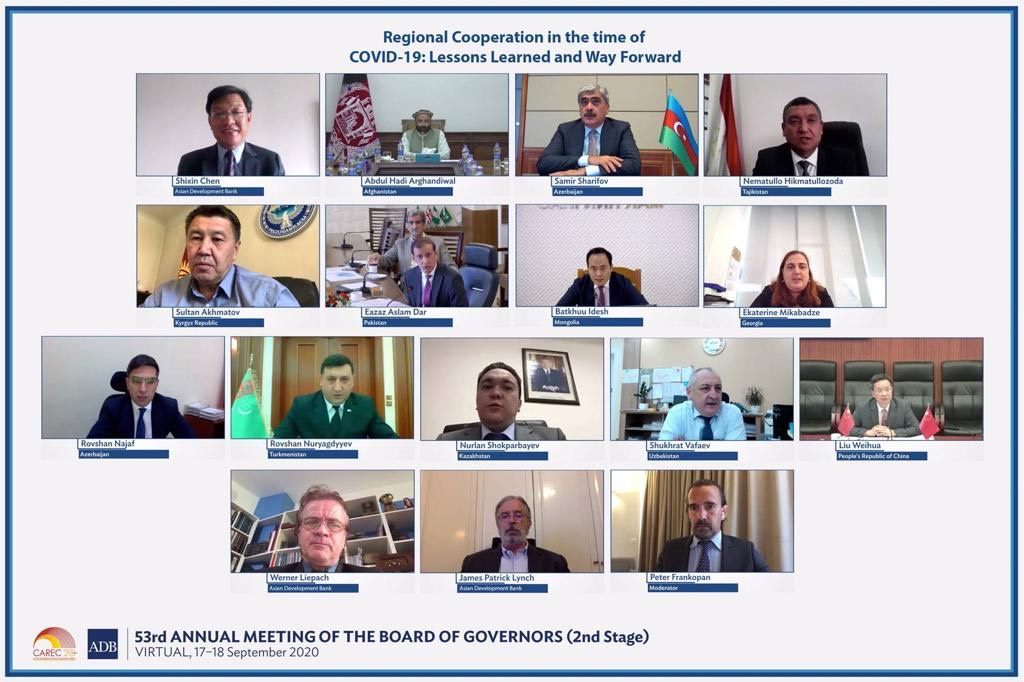Elvira Kadyrova
Virtual high-level session of CAREC Program at the 53rd Asian Development Bank (ADB) Annual General Meeting, which took place on 17 Sep, highlighted the benefits of better integration and policy harmonization for proceeding in post-Covid world.
Heads and deputies of economy and finance ministries and departments of Afghanistan, Azerbaijan, Uzbekistan, Tajikistan, Turkmenistan, Kazakhstan, China, Georgia, Kyrgyzstan, Mongolia, and Pakistan discussed regional Cooperation in the time of Covid-19, lessons Learned and way forward.
The meeting was welcomed by ADB Vice President Shixin Chen. The rapid spread of Covid-19 has manifested as the worst pandemic in a century and poses an unprecedented threat to both public health and the regional economy. The impact is being felt strongly across developing Asia, with a sharply reduced growth forecast of merely 0.1% in 2020, he said.
56 million people falling back into extreme poverty. In the CAREC region, excluding PRC, we expect economic activity to contract by 1.3% due to trade and travel disruptions, low oil prices, and loss of remittances, VP Chen stressed.
ADB approved around $2.8 billion in immediate assistance to the CAREC region to help contain the spread of the pandemic, deliver economic stimulus, ensure social protection, and support micro, small and medium-sized enterprises (MSMEs).
Shixin Chen also shared ADB’s thoughts for the future of regional cooperation on the CAREC platform, taking into account the realities of Covid-19.
First, there is a need to build a more resilient regional health system. A number of areas require improvement – such as strengthening regional integrated disease surveillance networks, establishing coordinated mechanisms to slow the spread of viruses across borders; harmonizing health protocols and standards across countries; and exploring pooled mechanisms for vaccine procurement.
Second, the region can better cooperate to overcome the barriers caused by climate change, as well as barriers regional connectivity, climate change, women’s participation in the labor force, cross-border trade and tourism, FDI and remittance inflows, as well as digitalization.
Third, CAREC countries should promote greater knowledge sharing. Joint actions are important for addressing common health diseases, cross-border economic enhancement, and coordinating regional policies.
Fourth, the potential for interregional cooperation should be explored. The matter is further integration and synergy of such platforms as CAREC, the Greater Mekong Sub-region, and the South Asia Subregional Economic Cooperation Program.
***
In Central Asia, Covid-19 incidence statistics are still growing, and the ADB expects economic activity to decline by 0.5% due to disruption of trade chains and travel restrictions. The pandemic has led to a sharp decline in services that depend on connectivity and human interaction, including transport, tourism and retail sales. In the CAREC countries, the services sector is expected to lose an average of 4% of GDP, compared to 1.6% of GDP – in industrial production and 1.3% of GDP – in agriculture.
Meanwhile, the impact of the pandemic on CAREC countries is uneven. For example, according to the Chinese general customs administration, in the first six months of 2020, the trade turnover between China and Kazakhstan decreased by only 1.5% compared to the same period last year, while the trade between China and Kyrgyzstan fell by more than 50%.
This challenging situation means that the focus on improving the efficiency of the six CAREC transport corridors, on border crossing speeds, and on internal monitoring and reporting capabilities remains vital. Finding ways to speed up trade exchanges is important for revitalizing national and regional economies and reducing the impact on health, economic and social issues.
South-East Asian countries have experienced several epidemics – the Asian flu (1957-1958), the Hong Kong flu (1968-1969), and SARS (2002-2004) – which have allowed them to learn valuable lessons in disease prevention, control, and information exchange. For this reason, Southeast Asia is coping with the aftershock of COVID-19 somewhat better than other regions of the world. Using this experience is extremely important for the future, as emerging infectious diseases are a problem both today and tomorrow.
***
For 20 years, the Central Asia Regional Economic Cooperation (CAREC) Program has been a reliable platform for shared and sustainable development through cooperation. Despite the challenges posed by the COVID-19 pandemic, CAREC’s member countries—Afghanistan, Azerbaijan, the People’s Republic of China, Georgia, Kazakhstan, the Kyrgyz Republic, Mongolia, Pakistan, Tajikistan, Turkmenistan and Uzbekistan—continue to work with development partners to achieve higher levels of economic growth and to reduce poverty in the region.
Video: 20 Years of CAREC: Working Together for Sustainable Development
https://www.adb.org/news/videos/20-years-carec-working-together-sustainable-development
/// nCa, 24 September 2020
